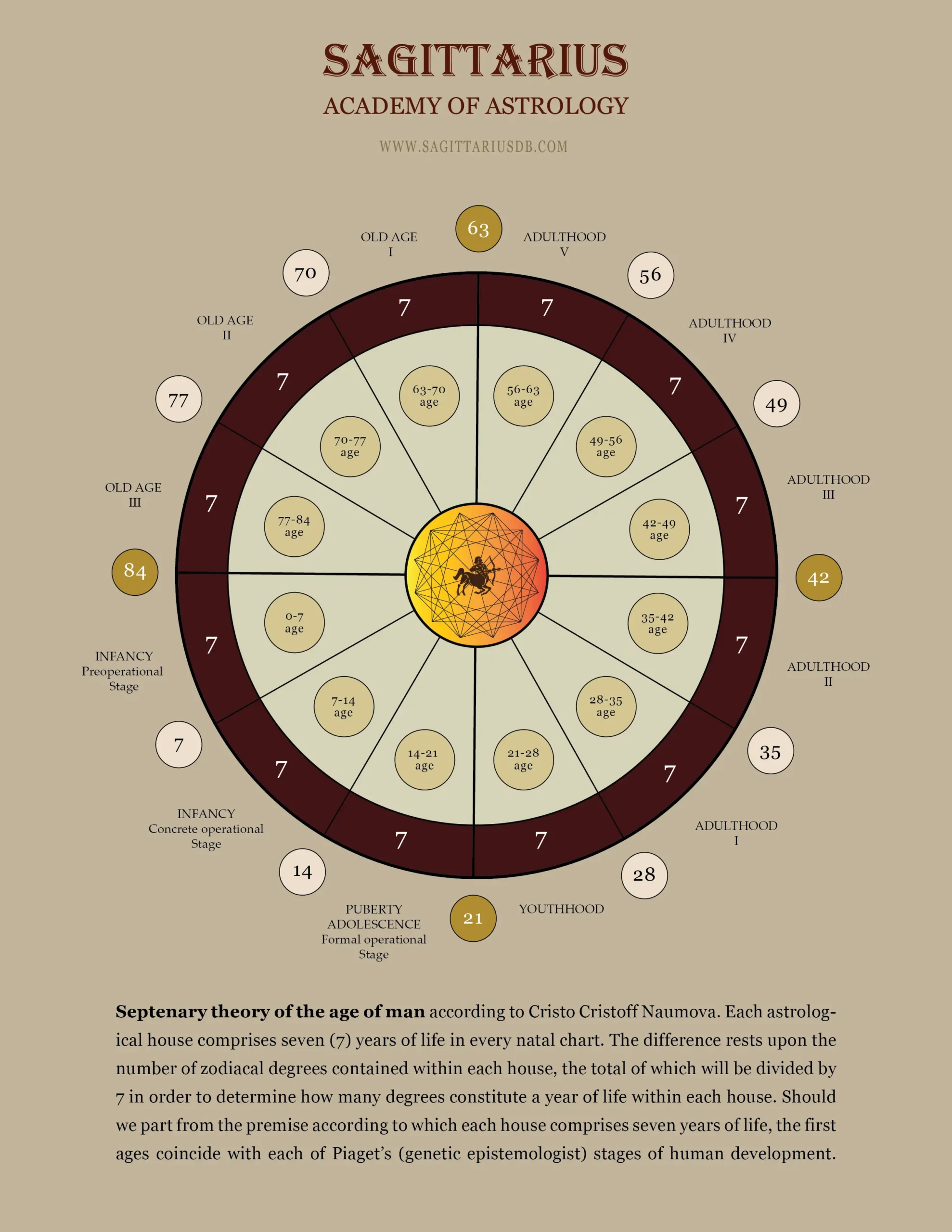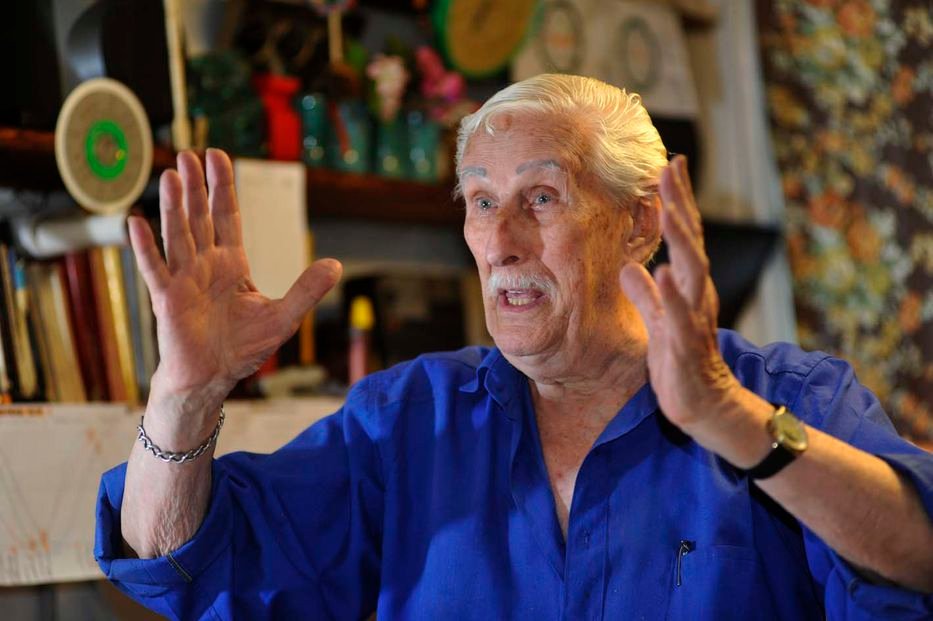Learn the reason for which it is said that certain Zodiacal degrees never rise within the polar regions.

The natural progression of the chart according to Cristoff
noviembre 14, 2024
Autor: David Bustamante S.
Learn the natural progression of the birthchart on the basis of a seven-year rhythm per house. It is how a Bulgarian-Uruguayan astrologer managed to make dozens of warnings and predictions.
Translator’s comment
The English-speaking astrological reader does not usually encounter an exciting or sensational language or style of writing, nor extraordinary statements, at least not if the author or authors are ancient or veterans. A relatively modest language tends to be encountered instead, but Cristoff, an astrologer with a vast knowledge of world literature, was characterised by an enthusiasm almost comparable to the optimism inherent in the sign of Leo and the hope which Jupiter keeps or holds within, and his statements can, in some parts of his work (Proluna, 1989. Kier. Buenos Aires), be considered a little exaggerated, although true. What is important, however, is the empiricism that characterises the relevance of the number seven, a number inextricably related to man for a reason that is the simplest of all those presented by Cristoff, or which sums them all up: Uranus (cycle of 84 years or 7 years for each segment of our ecliptic) represents the human race, not Mercury, for this little one, while constituting the same symbol, possesses not the scope of Uranus. Let us remember that the human being is not only homo sapiens, but sapiens-sapiens, that is, the ultra-modern man, and that the other half of its origin remains unknown to this day. (It is also the only species on Earth both homicidal and suicidal.) In «Astrophysical Justification of the Astrological Symbols» (January 2024, not yet translated into English) we bothered discussing the physical, biological, and cognitive basis of the number seven with regard to the rhythm of seven years of life per astrological house, as defended by Cristoff from 1963 (when he discovered the technique) until the day of his death (as opposed to five or six years of life, like others have posited and, while not unreasonable, we find inaccurate or applicable to a different plane than that of houses, such as Zodiacal releasing or relay, applicable to ecliptic segments, not houses). We therefore recommend consulting that part of the essay, available in both the PhilPapers and Zenodo research repositories.
Because this is only a fragment of Cristoff’s introduction to his method, he does not take care to describe the calculation but its justification (i.e. of the number seven instead of others, such as five or six). The calculation, however, is very simple, and parts from the premise according to which each astrological house (in any natal chart) measures seven years of life, whereby the number of total zodiacal or oblique degrees contained in each house of the chart must be determined in order to divide them, at each opportunity, by 7 for the purposes of establishing the amount of degrees that would constitute a year of life within that house (quadrant house, for the sake of clarity). While in some houses a year of life may span 4 or 5 ecliptic degrees (which is the average amount of degrees per house among those born not far from the equator), another may span only 2 or 3 or up to 7 or 8.
We present, before reading Cristoff, an illustration of said stages or periods of life, which coincide, from the first to the third, with the stages of cognitive development described by Jean Piaget (genetic epistemologist).
THE ROOTS OF PROLUNA: URANUS AND THE MOON
PROLUNA or PLN, which stands for NATURAL LUNAR PROGRESSION, is a symbolic progression that considers the human cycle to be composed or made up of twelve ages of 7 years each. This cycle begins with the birth of a person, represented by the Ascendant, and continues through successive house cusps [1] which, in turn, represent subsequent septennial ages.
I consider it LUNAR because the septennial cycle is linked to the lunar phases and therefore to the week, the unitary basis of our calendar. On the other hand, the planet Uranus, which represents astrology itself, has a coincident cycle around the sun, namely, 84 years. That is, it takes seven years to traverse each zodiacal sign. Looking at things through an analogue lens, the Uranus-moon binomial that inspires the technique would have the following meaning or symbol: the astrologer and his consultants, respectively, which reinforces my belief in the good roots of the method. In a knock-out exercise, none of the other planetary cycles even come close to the average human lifespan: Saturn, which is the planet immediately prior, presents us with a 30-year cycle, while Neptune, the planet immediately beyond, presents us with a 163-year cycle. [2] Between Uranus, which rules the human cycle, and the moon, which rules the week and the month, I preferred to use the latter by virtue of its consistent intervention in daily life.
I consider it NATURAL because it is the simplest of the known progressions, requiring no ephemeris or calculations, not to mention that it is also more natural for an astrological progression to be symbolic, like the astrological discipline itself, than realistic and exact as transits, primary, secondary, and tertiary progressions, and directions claim to be. The latter resembles the Cartesian materialism which, in the realm of human knowledge, leaves much to be desired, reason for which, within the integrity of astrology, the closest thing to it, because of its symbolic basis, is the PLN.
This approach, that is, from the general realm to the particular one [deductive reasoning], dogmatising thereby the average life cycle, is of great importance. From this follows the fact that, should the entire system be found wrong, the premise, then, would be false. However, in order to be sure, the reader will have sufficient proof at the end of this treatise, where what appears presented from the beginning will later prove its value and demonstrate too, that truth is not only reached through reason, but also through a sort of integration of instinct with both intuition and extuition.
THE TIME OF PROLUNA AND ITS DERIVATIVES
A horoscope can be constructed, that is, calculated and drawn, in about seven minutes. The graphical approach through the PLN can, in turn, be carried out in about 20 seconds, while its comprehension, roughly speaking, takes about 15. We therefore require about seven and a half minutes for a first synthesis, and a slightly more detailed interpretation would not take more than 20 minutes, which is what is required in today’s consulting room. Now, should we desire to investigate a life year by year and event by event, we could write a book of 300 pages, as I did with the study of The Three Lives of Christ, employing the PLN and its derivatives.
These periods or times of study, which will be considered to be exaggerated on both ends by those who employ other methods, never so global and, at the same time, never so detailed, are rigorously accurate according to a thirty-year long personal estimation through more than 9,500 horoscopes. Not even astrological computers, which offer and print out natal or yearly charts, can present such an advantage from a practical point of view, because reducing the seven minutes to one or less minutes does not justify the several hundred dollars of investment. Neither does the old square format or the complex circle over houses and aspects.
If it is true that a science is measured by its ability to foresee, astrology is the mother of sciences. Also, if an astrological progression such as the PLN makes it possible to visualise an entire destiny in 35 seconds (although its verbal expression can be extended to about 20 minutes), this constitutes only a miniscule part of the true value of this method and its system.
All reasoning should consider, first and foremost, the Universal Unity, then derive the particular concepts. This procedure being followed, within the PLN system, it is necessary to employ, first, the PLN itself, then its derivatives, that is, RESONA [years], the RELUNA [months], the REDIANA [days] and the REHONA [hours], in that order, in the analysis of a particular destiny.
THE NUMBER 7 AS THE SUPREME HUMAN NUMBER
Manuel Lino (Montevideo Portal)
I consider that there are human numbers and inhuman numbers. For some higher reason, our species is linked to some numbers more than to others. One needs look only into history, customs, folklore, religions, or the calendar, natural cycles and sciences to become convinced. The most popular and repeated number in popular sayings and sentences is the number seven, a number undoubtedly much more used than many others, such as twelve, three, and four. Numbers such as eight, nine, or thirteen are inhuman numbers or not linked to our course or destiny.
Certainly, our civilisation presents this cycle more than any other: God created the world in seven days according to the Bible, which also mentions the 7 archangels that surround him, the 7 virtues, the 7 sorrows and joys of the Virgin. Lent lasts 7 weeks and Pentecost is celebrated 7 weeks after Easter. But it is in everyday matters that the seven reigns: the 7 days of the week, the 7 colours of the rainbow, the 7 musical notes, the 7 visible stars of our solar system, the 7 sins, the 7 seas, the 7 lives of the cat, the 7 years of bad luck or of good luck, ‘the 7-year itch’, the 7 days of each lunar phase, the seven samurai, making ‘a seven on your dress’ (instead of an L or a 1), the septentrion (i.e. the north pole, the one who has the Ursa Major or Great Bear, which is a constellation of 7 stars), and so on.
Seven and its multiples also condition us enormously. The 7 years that mark the boundary between infancy and childhood are marked by the maximum dental development. The 14 years of age, in turn, are marked by sexual development in girls and by a change of their voice in boys. We recall that a majority of nations consider, in their codes, that the age of majority is 21, even though one may be able to vote earlier or become liable for previous punishable offences. A 1982 statistic also gave an average age of 21 for most marriages in the United States [3], one of the three largest nations in the world. The age of 28 seems to be the limit of growth or general development of the human organism. Cholesterol peaks at 56 (eight times seven) and lung decline takes place at 70 (ten times seven). The age of 42 (six times seven) marks the critical age: menopause and andropause, depending on the sex, etcetera.
In antiquity, seven precedes any other number: the 7 sins, the 7 wise men of Greece, the 7 Chinese gods, the 7 fat cows and the 7 lean cows of Egypt, the 7 horsemen of the Apocalypse, the 7 spirits before the throne, the 7 arms of the Jewish candelabrum, the 7 wonders of the ancient world, the 7 plagues of Egypt, ‘The Seven against Thebes’, a play by Aeschylus, the Seven Partidas of Alfonso the Wise, seven as a vital number for Pythagoras, and according to Hippocrates, the father of medicine, in seven years the corporal and spiritual substance changes, and he affirmed that the most critical age of the individual was 49 and 63 (seven and nine times seven, respectively), ages which, in the PLN, correspond, respectively, to the eighth house (death) and the tenth or midheaven (passage from maturity to old age).
Geography abounds in septennial terms such as: the 7 winds, the 7 seas, the 7 parts of the Earth (the two Americas, Europe, Asia, Africa, Australia and Antarctica), the 7 estuaries, the 7 ages, the 7 deserts, and so on. Astronomy too: the 7 heavens, the 7 heads of the Hydra, the 7 stars of the Ursa, the 7 nights when the comet was seen after the assassination of Caesar, and so on.
History speaks of the Seven Years’ War, of the Seven Heads of Thebes, of the 7 cities that disputed to be the birthplace of Homer. Even children’s stories adopt this number with ‘Snow White and the Seven Dwarfs’, ‘The Seven-league boots’, and so on. Astrology too abounds in this cycle: the 7 astrological aspects, the 7 visible stars, the 7 days of the moon phases and the week, the 7 years of the transit of Uranus, and so on. The religions of various continents and epochs, about which we are not aware of exchanges, documented it in this way. Jesus said to Peter: «Not seven, but seventy-seven» (Matthew 18:22). In Ahu Akivi (Easter Island), there are seven moai; in China, there are seven gods; the Jews, for their part, consider seven to be the supreme cabalistic number, and their candelabrum has seven arms; St. John, in his turn, employed this number extensively in his Revelation, the most enigmatic and prophetic part of the New Testament; the expression ‘the seven stars of the seven angels’, ‘the seven spirits before the throne’ is repeated. In Ecuador, in the Cave of the Tayos, an unknown civilisation decorated the best room with a table and seven chairs, the one after the seventh underground gallery.
The modern world keeps finding new septennial relationships. Russian scientists declare that the cosmos has seven states (modern work of Vasiliev) and the modern aerodynamic engineer Angelo Miele, who lives in the United States, declared that he attributes to the number seven an almost mystical meaning, after which he completed several studies: on the mechanics of flight, on aerodynamic shapes of aeroplanes, and on the most complex problems using electronic elaborators to create algorithms. Personally, this cycle is very close to my heart in my biography, and there is hardly a sector in which this important human number is not involved.
Given the pace at which I am discovering about the septennial cycle on a daily basis, this list seems very small to me. However, it is enough to provide us with an idea. Other human numbers would seem to be 1, 2, 3, 4, and 12, as they are part of many natural rhythms, time cycles, and geometrical schemes. In the mineral kingdom (the 7 periods of Mendeleev’s Periodic Table of the elements) as well as in the plant kingdom and in the animal kingdom (natural cycles of development, physical and psychic evolution, among others), seven is an incomparable cycle in our perception of the Universe and is therefore the supreme number for the purpose of an astrological progression.
Together with the number twelve (12), the number seven (7) forms an incomparable scheme in life. Both numbers are formed by the sum and product of two other particularly important numbers: three (3) and four (4), that is, 3 + 4 = 7, and 3 x 4 = 12. They are rather different states of the same starting point, and although the twelve is an important cycle, it does not seem to compete with the seven, but to serve as a complement.
THE TWELVE (12) ADVANTAGES OF THE PLN
There are twelve original advantages or qualities in the PLN that are not found in the rest of the known timing techniques, and we will detail them below, and which are expressed in the twelve ages of seven years of our General Theory of the Ages of Man.
__________________
[1] It should be made clear that the seven years of life that each astrological house measures must be considered on the basis of a quadrant measurement of the chart, especially Placidus (timekeeping method or houses of proper time).
[2] Life expectancy should not, we think, be considered the decisive variable. While it is true that it coincides with proluna, especially when health care and diet are adequate (e.g. Scandinavia, Japan, Canada, some countries in Europe, etc.), life expectancy has always varied over the centuries and, if genetic engineering continues to advance, it may be possible for human life expectancy to go from 82 or 85 (in good conditions, according to the most recent statistics) to 92 or 98. The technique, however, should remain faithful to human development for different reasons, and the patterns we note in each of the septennial ages would continue to be verified in succession almost independently of cultural factors (that is, they would continue to be verified around most of the world). See corresponding section in our essay Astrophysical Justification of Astrological Symbols (January 2024) in the research repositories PhilPapers and Zenodo.
[3] Under the technique in question (i.e. seven years of life per house), the 21st birthday of any human is marked by the cusp of the fourth house, which is associated with domestic or household affairs. From a zodiacal point of view (a plane analogous to that of the houses, which is why there are twelve segments or sectors in both, as well as presenting or following the same order), the fourth sign is the sign of motherhood, but this characteristic of the period is applicable only to Latin American or American nativities, at least mostly.
Photographs: Manuel Lino (Montevideo Portal)














